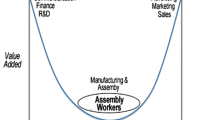Abstract
Information asymmetry is often a characteristic present in food value chains. However, high information asymmetry reduces trust and may compromise food safety and quality. Traceability enhances information sharing and disclosure thereby reducing the imperfection. Qualitative and quantitative data was collected from Kenyan certified farmers and organic outlets to generate empirical information on the extent and factors that contribute to traceability along organic kale value chains. Interviews were conducted using a semi-structured questionnaire. Data was analysed using descriptive statistics and factor analysis. Majority (62 %) of smallholder producers had a functional traceability system. Factor analysis revealed that organizational activities and personnel perception contribute to traceability in an organization. Variables that contribute to organizational activities are documentation/record keeping (0.754), certification by other quality management standards (0.711), training on food safety and traceability management (0.444) and system monitoring (0.770). Such knowledge can be used by players along the value chain to reduce information asymmetry. The results suggest need for awareness creation among stakeholders on how organizational activities can be used to improve traceability through enhanced information flow for safer and better quality organic products. In addition, perception of personnel which plays an important role in traceability can be improved through training personnel on beneficial consequences of a traceability system.




Similar content being viewed by others
References
Ajzen I (1991) The theory of planned behavior. Organ Behav Hum Decis Process 50(2):179–211
Bechini A, Cimino MG, Marcelloni F, Tomasi A (2008) Patterns and technologies for enabling supply chain traceability through collaborative e-business. Inf Softw Technol 50(4):342–359
Bertolini M, Bevilacqua M, Massini R (2006) FMECA approach to product traceability in the food industry. Food Control 17(2):137–145
Coff C (2006) The taste for ethics, an ethic of food consumption. Springer, Dordrecht
EAOPS (2007) East African Standard EAS 456: 2007. East African organic products standard
FAO/WHO (2005) Human vitamin and mineral requirements. Report of a joint FAO/WHO expert consultation Bangkok, Thailand. Food and Agriculture Organization of the United Nations, Rome
Field A (2000) Discovering statistics using SPSS for Windows. Sage publications, London–Thousand Oaks–New Delhi
Fritz F, Schiefer G (2008) Food chain management for sustainable food system development: a European research agenda. Agribusiness 24(4):440–452. doi:10.1002/agr.20172
Gawron J, Theuvsen L (2009) The international food standard: bureaucratic burden or helpful management instrument in global markets? Empirical results from the German food industry. J Int Food Agribusiness Mark 21(4):239–252
Golan E, Krissoff B, Kuchler F, Calvin L, Nelson K, Price G (2004) Traceability in the US food supply: economic theory and industry studies. In: Agricultural Economic Report 830. ERS, USDA, Washington, DC
Hall D (2010) Food with a visible face: traceability and the public promotion of private governance in the Japanese food system. Geoforum 41:826–835
Heyder M, Theuvsen L, Hollmann-Hespos T (2012) Investments in tracking and tracing systems in the food industry: a PLS analysis. Food Policy 37:102–113
Hobbs JE (2004) Information asymmetry and the role of traceability systems. Agribusiness 20(4):397–415
International Organization for Standardization (1994). ISO standard 8402:1994, http://www.iso.org
ISO (2005) Traceability in the feed and food chain. General Principles and Basic Requirements for System Design and Implementation. ISO 22005:2005
Kledal P, Oyiera H, Njoroge J, Kiarii E (2008) Organic food and farming in Kenya. Archived at http://orgprints.org/14758
Maldonado-Siman E, Godinez-Gonzalez C, Cadena-Meneses J, Ruíz-Flores A, Aranda-Osorio G (2012) Traceability in the Mexican dairy processing industry. Journal of Food Processing and Preservation 37(5):399–404 ISSN 1745–4549
Manikas I, Manos B (2008) Design of an integrated supply chain model for supporting traceability of dairy products. Int J Dairy Technol 62:126–138
Ponti T, Rijk B, Ittersum M (2012) The crop yield gap between organic and conventional agriculture. Agric Syst 108:1–9
Pouliot S, Sumner DA (2008) Traceability, liability, and incentives for food safety and quality. Am J Agric Econ 90(1):15–27
Prain, G. Blanca, A. and Karanja N. (2007). Horticulture in urban eco-systems: some socio-economic and environmental lessons from studies in three developing regions. http://www.database.ruaf.org/wuf/pdf/horticulture_uh.pdf Retrieved 26th August 2012
Raynaud E, Sauvée L, Valceschini E (2009) Aligning branding strategies and governance of vertical transactions in agri-food chains. Ind Corp Chang 18(5):835–868
Rietveld T, van Hout R (1993) Statistical techniques for the study of language and language behaviour. Mouton de Gruyter, Berlin–New York
Ruiz-Garcia L, Steinberger G, Rothmund M (2010) A model and prototype implementation for tracking and tracing agricultural batch products along the food chain. Food Control 21:112–121
Shackell G (2008) Traceability in the meat industry—the farm to plate continuum. Int J Food Sci Technol 43:2134–2142
Souza-Monteiro DM, Caswell JA (2010) The economics of voluntary traceability in multi-ingredient food chains. Agribusiness 26(1):122–142
Sporleder T, Moss L (2002) Knowledge management in the global food system: network embeddedness and social capital. Am J Agric Econ 84(5):1345–1352
SPSS (2008) SPSS Statistics for Windows, Version 17.0. SPSS Inc., Chicago
Xiaoshuan Z, Jian Z, Feng L, Zetian F, Weisong M (2010) Strengths and limitations on the operating mechanisms of traceability system in agro food, China. Food Control 21:825–829
Acknowledgments
We are immensely grateful to the Danish International Development Agency (DANIDA) for sponsoring the research through the ProGrOV (Productivity and Growth of Organic Value Chains) Project. We are grateful to the reviewers for their positive feedback that greatly improved the quality of the article.
Author information
Authors and Affiliations
Corresponding author
Rights and permissions
About this article
Cite this article
Gichure, J.N., Wahome, R.G., Njage, P.M.K. et al. Factors influencing extent of traceability along organic fresh produce value chains: case of kale in Nairobi, Kenya. Org. Agr. 7, 293–302 (2017). https://doi.org/10.1007/s13165-016-0155-5
Received:
Accepted:
Published:
Issue Date:
DOI: https://doi.org/10.1007/s13165-016-0155-5




